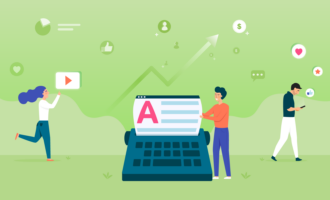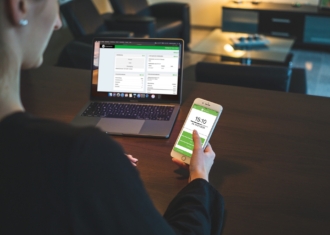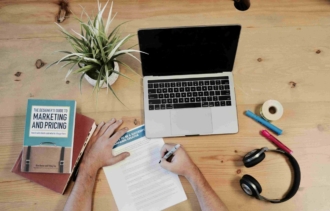One of the biggest mistakes a company can make with content marketing is creating content that has no purpose. You should always have an end goal or call to action that you want your readers to take.
Your call to action should also align with the stage of the content marketing funnel your reader is in. You don’t want to ask a reader to buy your product or subscribe to your content if it’s the first time they’re meeting you or your brand.
A content marketing funnel can personalize content for your audience, which leads to happy and engaged readers, customers, or subscribers.
What is a content marketing funnel?
A content marketing funnel generally has three stages: TOFU, MOFU, and BOFU. (Don’t worry! We’ll discuss this more in a minute.)
It’s a system that shows how consumers become aware of your business and eventually convert.
It’s called a funnel because the top contains the largest pool of people. You tend to lose individuals as you go through the funnel and qualify leads to see if they’re a good fit for your product or vice versa. The bottom of the funnel has the fewest leads, but that’s where the sale or conversion happens.
TOFU (aka the awareness or attract stage)
TOFU, while also a tasty food, stands for the top of the funnel. It’s the first content piece that gets the attention of your ideal audience.
The first stage gathers the biggest audience, as it’s all about educating and informing consumers. There is absolutely no selling in this stage. You must begin earning people’s trust during the TOFU stage before they can move any further. The quickest way to lose that trust is by trying to make a sale too early.
Some common content formats for the TOFU stage include
- Blog posts
- Infographics
- Videos
- Checklists
- Podcasts
- Social posts
MOFU (aka the relationship or engage stage)
We continue to educate and inspire our audience in the middle of the funnel (MOFU), but we also start to introduce our business and products or services.
This is the time to engage and build a relationship with the audience and nurture those leads.
Create content that’s targeted, personalized, and persuasive to achieve those goals.
There are many ways to accomplish this, but let’s use email marketing as an example. 💌 If someone subscribes to your emails, you can segment them into a specific group based on their pain points and challenges.
For example, let’s say you’re a cat food company, and your subscription form asks for the age of your customer’s cat. The needs of your audience are going to be different depending on whether they have a kitten or an elderly cat. By segmenting your audience based on age, you can send them more specific content tailored to their challenges.
You can send targeted drip campaigns to engage them and continue to earn their trust. This can help raise your profile with your audience because they’re getting more personalized information and therefore more valuable content.
The content you send during this stage usually inspires more action from the reader. They probably want more in-depth information and interaction with your company compared to the TOFU stage. This content is also more personalized to the reader’s pain points and challenges.
It’s common for brands to create the following types of content for the MOFU stage:
- White papers
- Case studies
- E-books
- Live events
- Worksheets
- Webinars
- Emails
BOFU (aka the conversion or purchase stage)
BOFU (bottom of the funnel) is the stage where a lead becomes a customer, subscriber, or loyal reader. Your sales team (or you, if you’re a one-person team 😊) mostly uses the content created in this stage.
The goal here is to make the conversion, whether that be a sale, a new subscriber, or a returning visitor. Your content should inspire the audience to purchase and position your business as a superior brand.
It’s all about your product or service and how it can uniquely solve your audience’s problems. Discuss the data (or testimonials) regarding using your product or service.
It’s easier to sell to your audience once you’ve earned their trust and successfully engaged with them.
Pro tip: Create a sense of urgency around purchasing your product or service. One example is to give a discount code that expires within a specified period, encouraging your audience to act fast.
Some ideal formats for the BOFU stage are
- Video testimonials
- Case studies
- Comparison charts
- Discount codes
- Contests and giveaways
Bonus stage: Delighting the customer
You put in a lot of effort to get new customers, but don’t forget to focus on the audience you currently have.
Your current customers, subscribers, or readers are easy to market to because they don’t need the TOFU or MOFU stages. You can skip straight to the bottom of the funnel since they already know, like, and trust you.
Providing your current customers with targeted or actionable content is a great way to keep them happy and engaged with your business.
Here are some tactics to delight your current audience:
- Problem-solving guides
- Referral bonuses
- Exclusive content only for them (for example, live Q&A sessions)
- Loyalty programs
- Customer satisfaction surveys and follow-up communications
- Birthday or anniversary emails
- Asking for suggestions on how to improve — and then enacting them!
Wrap-up
Is this what my audience wants to know in this stage of the funnel?
That’s the most important question to ask yourself when it comes to content marketing.
Create content with your audience in mind. It’s a good idea to monitor engagement with your content to see if it resonates with your audience. You can tweak as needed based on analytics.
If your content marketing can address your audience’s needs while building a relationship with them, then you’re on the right track!
















































































Send Comment:
1 Comments:
More than a year ago
A wonderful article and important advice for any organization with an objective of expanding its base and increasing sales.
Kudos to Sabra